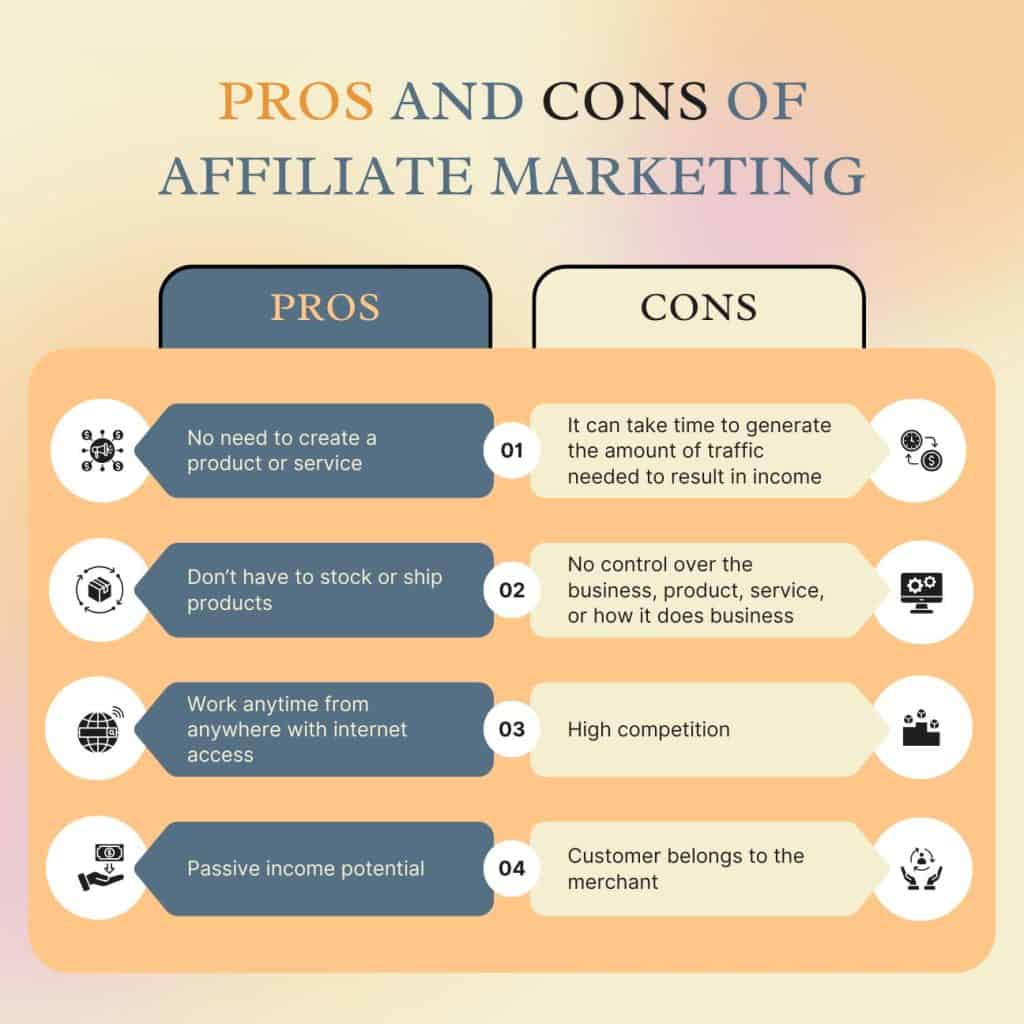A Balanced Guide for Aspiring Marketers
Affiliate marketing gets thrown around a lot as an easy way to make money online. The pitch is simple: recommend products, add a special link, and earn a commission when someone buys. It’s a model that now brings in billions for creators. The US affiliate marketing spend hit $13.62 billion in 2024, up ~50% since 2021, according to the Performance Marketing Association’s latest industry study. (Source: Performance Marketing Association, 2025)
It sounds almost too good to be true. No products to make, no shipping to handle, no customer service to deal with. Just content and links. But like anything in business, it comes with its upsides and its headaches. Let’s break down the real pros and cons of affiliate marketing so you can decide if it’s the right move for you.
What Affiliate Marketing Actually Is
At its core, affiliate marketing is about recommending products or services you don’t own. You join a program, get a unique tracking link, and whenever someone buys through it, you get paid.
There are usually three players in the mix:
-
Merchants: the brands behind the products (think Amazon, Shopify, or Nike).
-
Affiliates: people like you and me, creating content to spread the word.
-
Networks: the middlemen that provide tracking, dashboards, and payments.
If you’ve ever read a blog about “the best blogging tools” and clicked a link, you’ve probably taken part in affiliate marketing without even knowing it.
How to Get Started
Most beginners start by picking a niche they care about. Travel, tech, fitness, cooking — whatever you can talk about without running out of ideas. Then you join a program that fits. Amazon Associates is popular because it covers almost everything, but networks like ShareASale or ClickBank open doors to thousands of brands.
From there, it’s about creating content. Blog posts, YouTube videos, even TikToks — as long as you’re sharing helpful, honest info, you can naturally include your affiliate links. Add some SEO or social promotion into the mix, and you’re in business.
💡 Starting a blog and feeling stuck? Grab my free Blogging for Beginners Checklist — it covers niches, setup, and the essentials you actually need.
The Pros of Affiliate Marketing
The main reason so many people start with affiliate marketing is that the barrier to entry is almost nonexistent. You don’t need warehouses or investment. All you need is a laptop, internet connection, and a willingness to publish content.
Another big draw is the potential for passive income. A single article, video, or pin can keep earning long after you’ve published it. Imagine writing a blog post about the best hiking boots in 2025 — if it ranks on Google, that same post could still be bringing you commissions in 2026 without you lifting another finger.
Flexibility is another bonus. You can work from home, set your own hours, and reach people across the globe with just one link. Done right, it can grow into something scalable — you start small, test what works, and keep adding layers over time.
For a deeper look at the positives, I wrote a post on why blogging is still a business asset in 2025.
The Cons of Affiliate Marketing
Here’s the part people gloss over: affiliate marketing isn’t easy money. Competition is fierce, especially in big niches like health, fitness, and tech. You’re up against seasoned marketers, massive review sites like Wirecutter, and algorithm changes that can wipe out traffic overnight.
There’s also the issue of relying on other people’s rules. Affiliate programs can change commission rates, pause payments, or shut down entirely. Amazon famously cut its rates in 2020, and plenty of affiliates lost half their income overnight.
Then there’s the cash flow problem. Payments are often delayed by 30–60 days. Your earnings will fluctuate with seasons, trends, and even world events. It’s far from stable.
Lessons from the Field
Plenty of people have made affiliate marketing work. John Thornhill is a classic example — he left school at 16, spent years in manual jobs, then started selling on eBay before moving into digital products and affiliate marketing. Today he runs his own training programs and has built a full-time business online.
But there are just as many stories of people who jumped in too fast, relied only on Amazon, and found themselves stuck when commissions dropped. The lesson is clear: build your own audience, diversify your income, and don’t put all your eggs in one basket.
If you’d like to see an honest example of a program that helps beginners make sense of affiliate marketing, check out my Master Affiliate Profits (MAP) review
How to Tilt the Odds in Your Favour
If you want affiliate marketing to work for you, the strategy is simple — though not necessarily easy:
-
Create genuinely useful content. Don’t just drop links. Share pros, cons, and real opinions.
-
Diversify programs. Use Amazon, but also test ClickBank, CJ Affiliate, or smaller niche networks.
-
Track performance. Tools like Google Analytics or affiliate dashboards show what’s working. Double down on that.
-
Build an email list. Social media algorithms and Google updates change — your email list is yours.
For a quick starter guide, download my free Affiliate Marketing Mistakes Checklist. It shows you the common traps beginners fall into and how to avoid them.
The Bottom Line
Affiliate marketing isn’t a golden ticket, but it can be a solid way to earn online if you treat it like a real business. The pros — low costs, flexibility, and scalability — make it worth exploring. The cons — competition, policy changes, and unpredictable income — mean you’ll need patience and persistence.
If you’re the kind of person who enjoys creating content and doesn’t mind playing the long game, it could be a great fit. Start with one program, one niche, and one piece of content. Then measure, tweak, and build from there.
That’s how affiliate marketers who succeed actually do it.
Over to You
Ready to give affiliate marketing a try? Start by grabbing my free Affiliate Marketing Mistakes Checklist — it’ll save you months of frustration.
And if you’re curious about a beginner-friendly program that’s helped me simplify my own business no-end and offers super support, click here to get your free account with Master Affiliate Profits.
FAQs About Affiliate Marketing
Is affiliate marketing worth it in 2025?
Yes, but only if you treat it like a real business. The low costs and flexibility make it attractive, but success takes patience, consistent content, and a focus on building trust.
What’s the biggest downside of affiliate marketing?
You don’t control the products, the programs, or the payout rules. Commissions can change overnight, and traffic from Google or social platforms can dip without warning.
Can I start affiliate marketing for free?
You can. Joining most affiliate programs is free, and you don’t need inventory or shipping. At the very least you’ll need a blog or social platform, plus time to create useful content that attracts clicks.
Want no-fluff tips for building your online biz?
If this post gave you a lightbulb moment or a sigh of relief, you're not alone — that's exactly why I started sharing what I've learned.
Pop your name and email below and I'll send you beginner-friendly advice, useful tools, and the truth behind what really works online — straight to your inbox, no pressure.
👇 Sign up below and let's do this together.
Affiliate Note: Some of the links above are affiliate links, which means if you decide to purchase through them, I may earn a small commission — at no extra cost to you.
I only recommend tools I truly believe in and use myself. It helps support my blog and keeps the coffee flowing ☕
💬 Over to You:
What’s one thing you wish someone had told you before starting your online business?
I'd love to hear it — just hit reply to any of my emails and tell me, or share it with me over on my Facebook page. I read every single one.
SHARE – If you found this post helpful, why not share it with someone else who’s figuring it out too?


